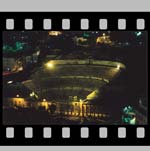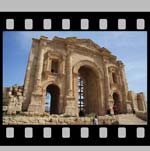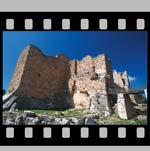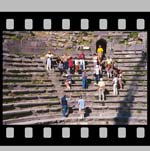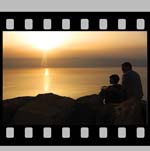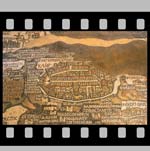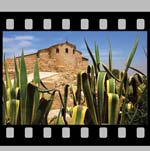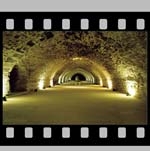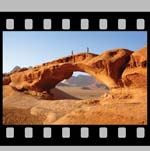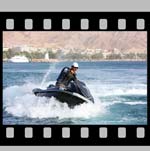Discover Amman
Amman – Desert Castles – Jerash – Ajloun –
Umm Qais –
Madaba – Nebo – Kerak – Petra –
Little Petra –
Wadi Rum – Aqaba
8 Days – 7 nights
Day 1: Arrive in Amman
Arrival: -
Arrive to Queen Alia International
Airport. Meet &
Assist by our representative, to finish your formalities, throw out the
immigration, meet your Driver, and then drive to Amman to your hotel.
Day2: Amman: City Tour – Desert Castles.
Breakfast: buffet breakfast at your hotel in Amman
this morning we tour Amman,
visiting the Roman amphitheatre, Folklore
Museum, Museum
of Popular Traditions, Archaeological Museum,
and the ruins of the Temple
of Hercules.
Amman, the modern and
ancient capital of Jordan,
is one of the oldest continuously inhabited cities in the World. The city's
modern buildings blend with the remnants of ancient civilizations
This afternoon we travel east from Amman
into the Jordanian
Desert. Here we see some
of the Desert Palaces built by the Umayyad Caliphs in the 8th century AD. Of
particular interest is Qaser Amra with its unique frescoes of hunting scenes
and dancing girls. Qaser Azraq, built entirely of black basalt, was used as a
base by Lawrence of Arabia in his later campaigns against the Turks.
We return to Amman via a road that
is one of the main trade route between Jordan
and nearby Iraq.
Back to the Hotel for Dinner
and over night.
Day3: Amman
– Um Qais – Ajloun – Jerash – Dead Sea.
Breakfast: buffet breakfast at your
hotel in Amman.
Transfer to
visit Um Qais.
The modern town
of Umm Qais is the site of the ancient Greco-Roman town of Gadara, one
of the cities of the Decapolis and, according to the Bible, the place where
Jesus cast out the devil from two men into a herd of pigs (Matthew 8: 28-34). Gadara was renowned for
its cosmopolitan atmosphere, attracting an array of writers, artists,
philosophers and poets.
Head to visit Ajloun
The main attraction in ‘Ajloun is the
stronghold of Qala’at al-Rabadh, a fine example
of medieval Arab/Islamic military architecture. The castle was built between
1184-85 CE by the nephew of Salah Eddin al-Ayyubi (known in the
West as Saladin), The fortress is built upon the
apex of the hill above ‘Ajloun, and offers a breathtaking view of the
surrounding countryside. On a clear day you can see the Dead Sea, the Jordan Valley,
the West Bank, and Lake Tiberias (the Sea of Galilee).
Proceed to Jerash for a visit which
is 25 KM from Ajloun.
Second only to Petra in tourist appeal, the ancient city of Jerash in remarkable for
its long chain of human occupation. Here
at a well-watered site in the hills of Gilead,
remains from Neolithic times have been found, as well as Greek, Roman,
Byzantine, Umayyad and others. Jerash’s
golden age, however arrived with Roman rule.
Today it is acknowledged as one of the best-preserved province cities of
the Roman Empire. Jerash was a member of the Decapolis,
a dynamic commercial league of ten Greco-Roman Cities.
Back to the Hotel for Dinner
and over night.
Day4: Amman - Mount
Nebo – Madaba – Kerak – Petra
Breakfast: buffet breakfast at your
hotel.
Transfer to Mount
Nebo for a visit
The mountain where Moses was
allowed to see the Holy Land … and not allowed
to enter it. Nowadays the mountain is a memorial site. Here is the “Church of Moses”,
built by the first Christians. Ever
since the first days of Christianity this mountain has been a holy place and a
destination for pilgrimage. Like Moses, you can have a great view over Jordan, the Dead Sea and Israel. When the weather is clear, you should even be
able to see Jerusalem,
which is about 60 kilometers away.
The Drive to Madaba for a visit. (5 minutes drive).
Madaba South of Amman proudly stands
the “City of Mosaics”,
Madaba, perched on an archaeological site with more than 4000 years of history
buried beneath it. The quality and
quantity of mosaic flooring has made Madaba one of the most prominent cities in
the world for mosaics. St. George’s
Church houses the world famous mosaic
floor depicting a large mosaic map of Palestine. Centrally located on this mosaic floor is a
detailed map of Jerusalem
as it was during the sixth century AD.
At the Church of the Apostles, at the southern entrance of the city, is
a mosaic floor attributed to the craftsman Salamanios, depicting the Sea, with
the central figure of a woman encircled with a selection of creatures,
vegetation and an inscription.
Afterward we drive to Kerak along the famous ancient
biblical caravan route the King's Way. We have a short stop in Wadi Al-Mujib, a
great wide valley with magnificent geological formation. Visit in Kerak.
The fortress was built for defense rather than beauty. But to
walk the battlements and the subterranean passageways gives one a true feeling
of its formidable presence.
There is a museum within the fortress in a vast
vaulted hall. It is reached by a few steps that lead down from the ground
level. Among the artifacts are fine glass bowls and flasks. Another great
hallway is situated below the Kerak museum hall. It is reached by a separate
set of stairs and the legend has it that it was there that Saladin had his
throne. The famous Crusader
castle built in 1132/34 by King Baldwin I. of Jerusalem.
Proceed to Petra.
Day5: Petra
Visit
Breakfast: buffet breakfast at your
hotel in Petra.
Start the visit with a horse
ride from the main gate of Petra
to the entrance of the old city (around 800 meters ride).
Then walk on foot along the
« Siq » to visit the rose-red city of Petra.
The ancient city of Petra was built from 800
BC to 100 AD by Nabetean Arabs. In this
era Petra was a
fortress, carved out of craggy rocks in an area, which was virtually
inaccessible. In the first and second
century, after the Romans took over, the city reached the peak of its
fame. Petra covers an area of about 100 square km,
where over 800 monuments can be found.
When shipping slowly displaced caravan routes, the city’s importance
gradually dwindled; it fell into disuse and was lost to the world until 1812,
when it was re-discovered by the Swiss explorer Johann Ludwig Burkhart.
Nowadays Petra is Jordan’s number 1 tourist
attraction, known as the “rose-red city half as old as time”. The Khazneh (the
Treasury), starred in Indiana Jones and the Last Crusade.
The Treasury is merely
the first of the many wonders that make up Petra. You will need at least four or five
days to really explore everything here. As you enter the Petra valley you will be overwhelmed by the
natural beauty of this place and its outstanding architectural achievements.
There are hundreds of elaborate rock-cut tombs with intricate carvings - unlike
the houses, which were destroyed mostly by earthquakes, the tombs were carved
to last throughout the afterlife and 500 have survived, empty but bewitching as
you file past their dark openings. Here also is a massive Nabatean-built.
Back to your hotel in Petra.
Day6: Petra – Little Petra – Wadi Rum.
Breakfast: buffet breakfast at your
hotel in Petra.
Checkout: check out from hotel and
luggage will be stored at your vehicle.
This morning we take a tour to the nearby site of 'el Beidha'
(known as 'Little Petra'). We will also see a settlement dating from the
Neolithic period, some 8,500 years ago. This is one of the oldest sights in the
Middle East; it shows evidence of habitation
by a Pre-Pottery population who were herders experimenting with agriculture.
Then Transfer to Wadi Rum (1h.30 minutes drive),.
Overnight: Bedwien Camp.
Day7: Wadi Rum – Aqaba
Breakfast: buffet breakfast at the
Camp in Wadi Rum.
Checkout: check out from hotel and
luggage will be stored at your vehicle.
Transfer to Aqaba (40. minutes drive), then Proceed to your Hotel.
AT
09.00 after the breakfast drive to visit Aqaba for free day at leisure, for
swimming over there and shopping.
With its wealth of
other attractions, Jordan’s
splendid Red Sea resort is often overlooked by
modern-day visitors. But apart from being a delightful place for discerning
holidaymakers, this is actually a great base from which to explore various
places of interest in southern Jordan.
Overnight
Day8: Aqaba – QAIA.
Breakfast: buffet breakfast at your
hotel in Amman.
Checkout: check out from hotel and
luggage will be stored at your vehicle.
You will be
transferred to Queen
Alia International
Airport for Departure.
End
of our Services.
Tour Include:-
1. Transportation: (New Air-conditioned
Vehicle)
2. English Speaking Driver
3. Water & soft drinks in vehicle
during the tour.
4. Fuel.
5. Sales Tax
Not Included in The
Tour:-
- Hotel Accommodation.
- Entrance Fees to all sites mentioned in the above program.
- Personal Expenses
- Tips to the driver
- Drinks in
Restaurants mentioned in the program.
